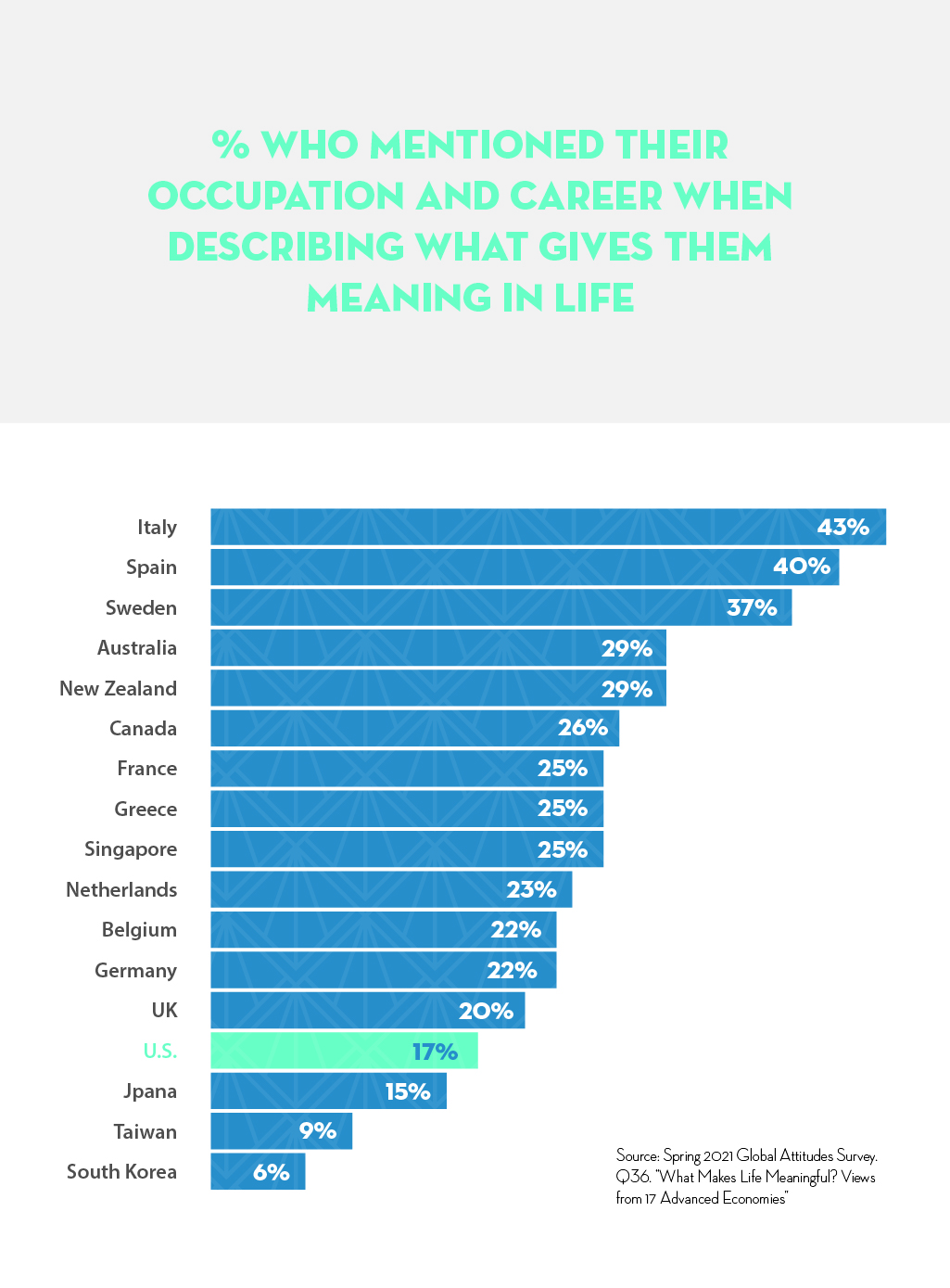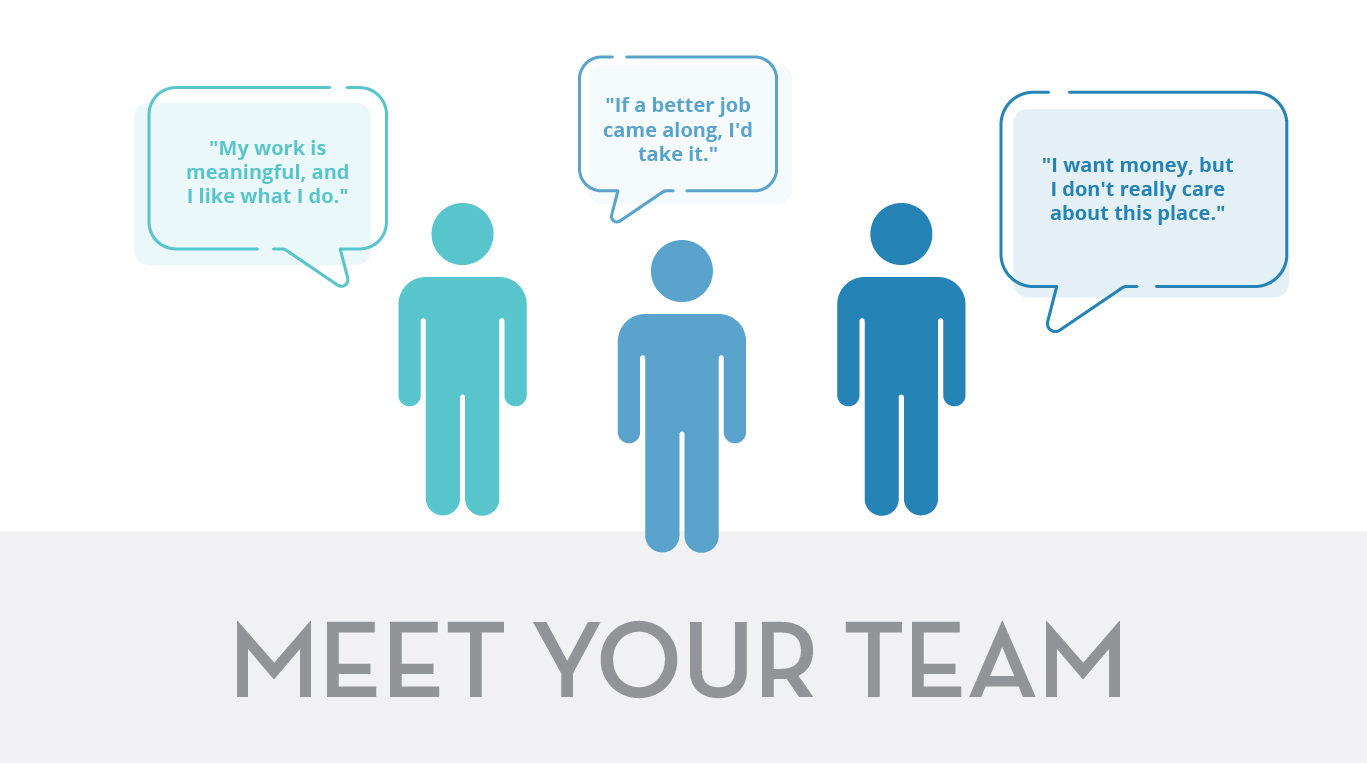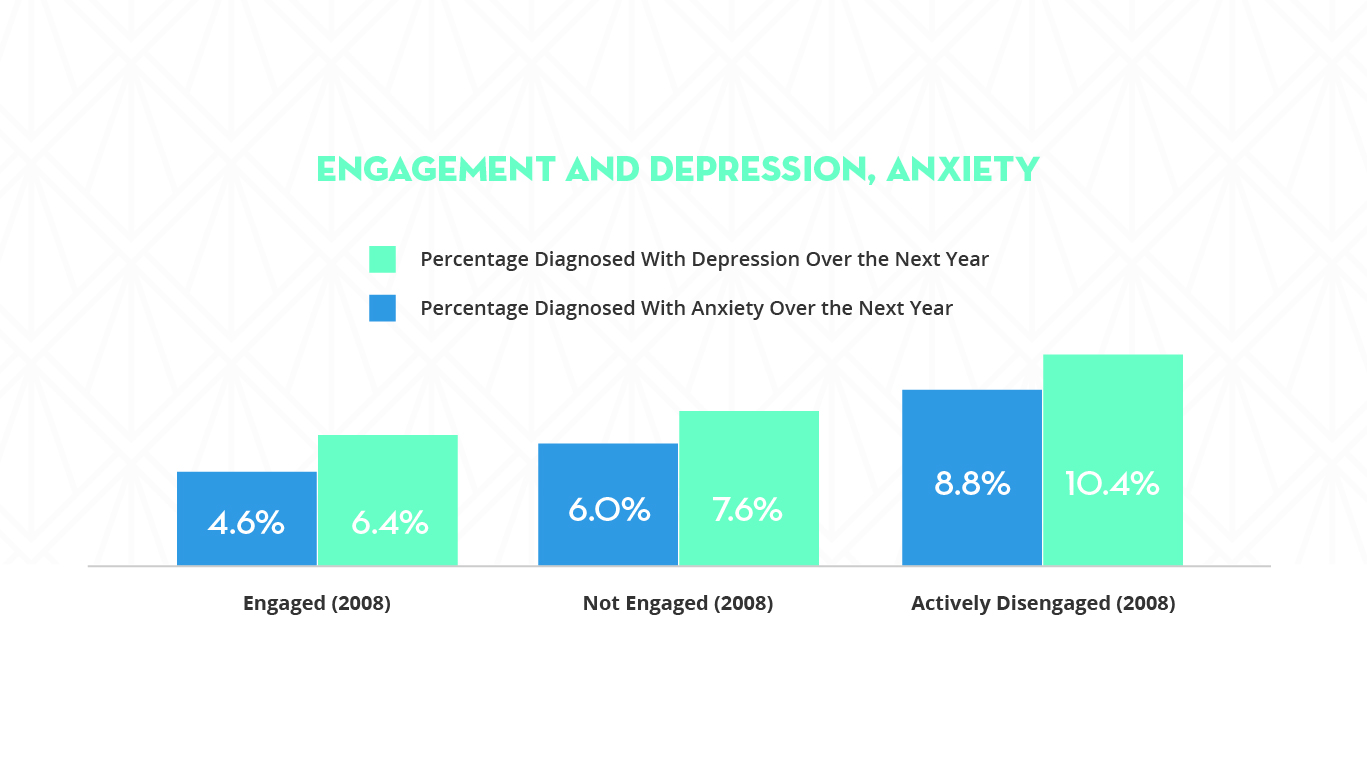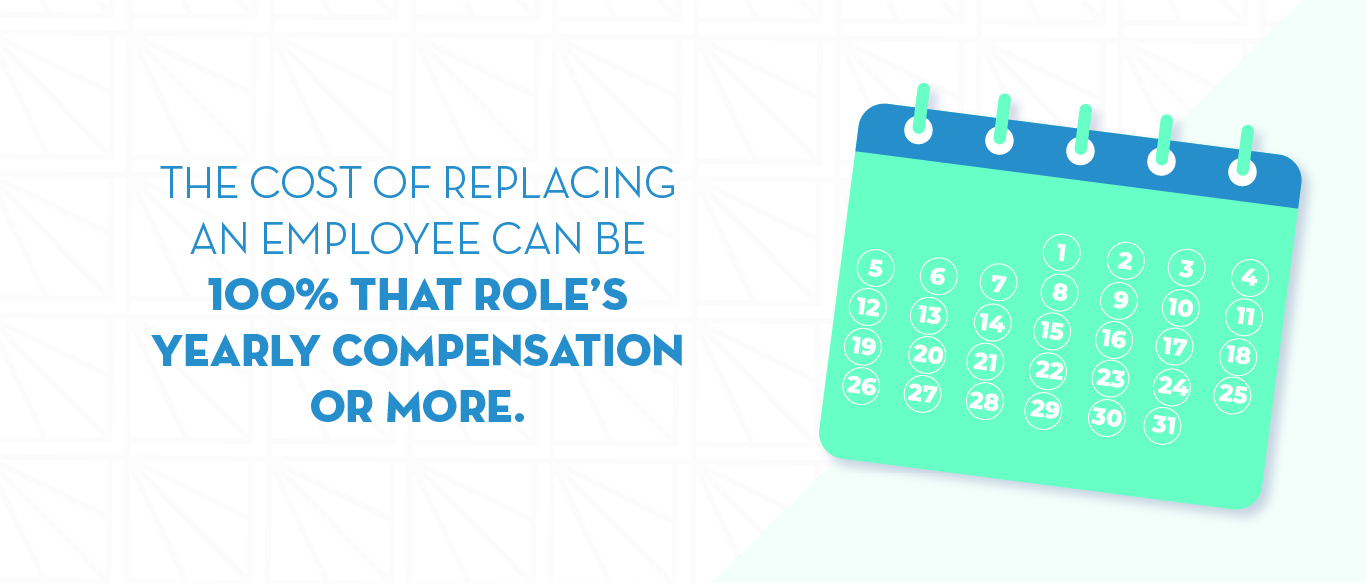Considering Americans spend about a third of their lives at work, you’d think we would derive a great deal of meaning from what we do. When we look at workers around the world, this is usually the case, but surprisingly it is not true of Americans—at least not in recent years.
What Makes Life Meaningful for Americans? Not Work, Apparently.
A Pew Research Center analysis of survey data from some of the world’s most advanced economies showed that people in the majority of cultures ranked their work as one of the top two sources for “what makes life meaningful.” However, only 17% of Americans mentioned it in their responses, making it a distant fourth place.
The data also show that Americans aren’t exactly “thriving” at work. While they’re generally satisfied with their jobs, only 42% report that their jobs give them a sense of identity, and nearly a third said their work is “just a job to get them by.”
Imagine that: every third person that walks by your workstation is just phoning it in to get by. Or maybe you’re one of every three people who’ll read this article and say “yup, that’s me. 5pm can’t come fast enough.”

Employee (Dis)engagement
“Fine,” you say, “I don’t need my people to get identity from work—it’s good enough if they just care while they’re here.”
I’ve got bad news for you. While we’ve had a few small gains here or there, employee engagement—a measure of how enthusiastic or involved employees are in their organizations—has remained below 36% for the past decade.

Why?
Worker perceptions of their workplace are incredibly complex, but there are a couple of drivers that deserve attention.
- A lack of understanding about the meaning of their work. People need to understand how their contributions are meaningful in creating the world they want to live in. Bad onboarding, weak company values or inconsistent internal communication leads people to feel disconnected from the vision, even if you have a good one.
- Americans don’t feel genuinely cared for at work. When researchers asked American workers in a survey whether or not their company cares about their well-being, only 24% said that was true. Just caring about your employees is not enough. They need to feel that you care. If they don’t feel cared for, research has shown that they’re more likely to quit or burn out.
The Real Costs of Disengagement
1. Disengagement is Bad for Your Employees’ Health
Disengagement and burnout are bad for an individual’s health, both mentally and physically. “Burnout” in itself is not a great place to be mentally, but research has also shown that employee disengagement predicts increased levels of anxiety and depression.
The extent of disengagement matters too. One longitudinal study showed that workers who were “actively disengaged” at work received more diagnoses of anxiety and depression over the next year than those who were simply “not engaged.”

There are also physical health ramifications to disengagement. A meta-analysis of studies on burnout showed significant correlations between burnout and all types of physical health problems, including:
- High cholesterol
- Congenital heart disease
- Musculoskeletal pain
- Pain experience
- Fatigue
- Gastrointestinal issues
- And even higher mortality rates
Conversely, employee engagement is connected to better overall well-being. One study showed that engagement correlated positively with not only higher levels of psychological well-being but also positive workplace psychological climate, increased sense of personal accomplishment, reduced stress and reduced emotional exhaustion.
2. Disengagement is Bad for Your Bottom Line

Disengagement is straight-up bad for business. Globally, it’s a multi-trillion dollar problem. Gallup analyses estimate that “low engagement costs the global economy US$7.8 trillion and accounts for 11% of GDP globally.”
The specific mechanics of how this works are many, but there a couple of big ones that stand out:
1. THEY DON’T SHOW UP
One study showed that burnout predicted an increase of 21% in sickness absence days each year. Whether they’re legitimate or phony, the damage to your bottom line is real.
2. THEY QUIT OR QUIET QUIT
The costs go up again when disengaged employees finally quit. Estimates differ by industry, but analyses show the cost of replacing an employee can be 100% that role’s yearly compensation or more. If you’re less lucky, they’ll hang around “not working” while they drain the energy from everyone around them.

As you might expect, companies who have cracked the case on engagement tend to be more profitable. A meta-analysis of survey data showed that that companies that ranked top-quartile for employee engagement:
- Demonstrated higher employee productivity,
- Did a better job of retaining employees, and
- Had an average of 21% higher profits.
How to Improve Engagement
If you’re like us, and you don’t hate your employees or profits, you’re probably curious how to see an increase in engagement.
The tricky thing is that employee engagement—while it has its own symptoms—is itself a symptom, not a disease. And like any good doctor, you need to listen to your patient and gather a bit more information before you can make a diagnosis and start the treatment.
Here’s a few questions you can ask to get started:
- Are my employees engaged? Run a survey and find out.
- Are we recruiting the right kind of people? Do you make values-alignment a bright-line in your hiring process?
- By the time they finish onboarding, do our new hires understand how their contributions are meaningful?
- Are my people growing personally and professionally? Are they challenged?
- Do they feel cared for?
- Do we have a regular system of internal communication that works?
- Do we have reliable metrics based on honest feedback from anonymous surveys?
Shameless Plug
Boileau & Co. does this stuff professionally. Yes, you can do all of these things yourself. But if it seems overwhelming or you just need a hand with part of it, send us an email or give us a call at (616) 786-4461. We can grab a coffee and talk about it.
Further Reading
Borritz, M., Rugulies, R., Christensen, K. B., Villadsen, E., & Kristensen, T. S. (2006). Burnout as a predictor of self-reported sickness absence among human service workers: prospective findings from three year follow up of the PUMA study. Occupational and environmental medicine, 63(2), 98–106. https://doi.org/10.1136/oem.2004.019364
Gallup. (2022). State of the global workplace 2022 report. https://www.gallup.com/file/workplace/349484/state-of-the-global-workplace-2022-download.pdf
Harter, J. (2018a, August 26). Employee Engagement on the Rise in the U.S. Gallup. https://news.gallup.com/poll/241649/employee-engagement-rise.aspx
Harter, J. (2022a, January 7). U.S. Employee engagement drops for first year in a decade. Gallup. https://www.gallup.com/workplace/388481/employee-engagement-drops-first-year-decade.aspx
Harter, J. (2022b, March 18). Percent who feel employer cares about their wellbeing plummets. Gallup. https://www.gallup.com/workplace/390776/percent-feel-employer-cares-Wellbeing-plummets.aspx
Harter, J. K., Schmidt, F. L., & Keyes, C. L. M. (2003). Well-being in the workplace and its relationship to business outcomes: A review of the Gallup studies. In C. L. M. Keyes & J. Haidt (Eds.), Flourishing: Positive psychology and the life well-lived (pp. 205–224). American Psychological Association. https://doi.org/10.1037/10594-009
Pew Research Center. (2016). The state of American jobs: How the shifting economic landscape is reshaping work and society and affecting the way people think about the skills and training they need to get ahead. https://www.pewresearch.org/social-trends/wp-content/uploads/sites/3/2016/10/ST_2016.10.06_Future-of-Work_FINAL4-1.pdf
Pew Research Center. (2021) What Makes Life Meaningful? Views From 17 Advanced Economies. https://www.pewresearch.org/global/wp-content/uploads/sites/2/2021/11/PG_11.18.21_meaning-in-life_fullreport.pdf
Robison, J. (2010, April 2). Disengagement can be really depressing. Gallup. https://news.gallup.com/businessjournal/127100/disengagement-really-depressing.aspx
Salvagioni, D. A. J., Melanda, F. N., Mesas, A. E., González, A. D., Gabani, F. L., & Andrade, S. M. (2017). Physical, psychological and occupational consequences of job burnout: A systematic review of prospective studies. PloS one, 12(10), e0185781. https://doi.org/10.1371/journal.pone.0185781
Shuck, B. & Reio, T. (2013). Employee Engagement and Well-Being. Journal of Leadership & Organizational Studies. 21. 43-58. https://doi.org/10.1177/1548051813494240Skelton, A. R., Nattress, D., & Dwyer, R. J. (2019). Predicting manufacturing employee turnover intentions. Journal of Economics, Finance and Administrative Science, 25(49), 101–117. https://doi.org/10.1108/JEFAS-07-2018-0069


